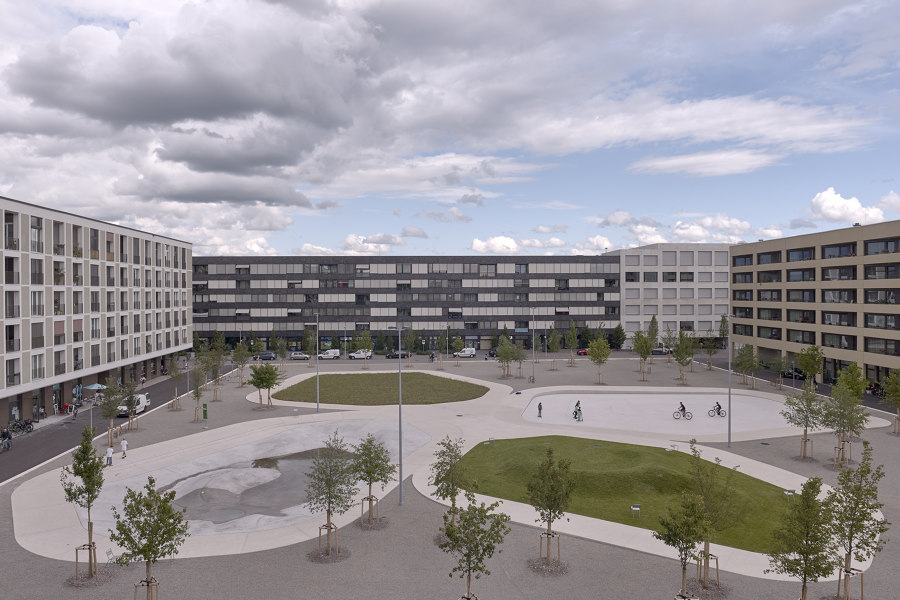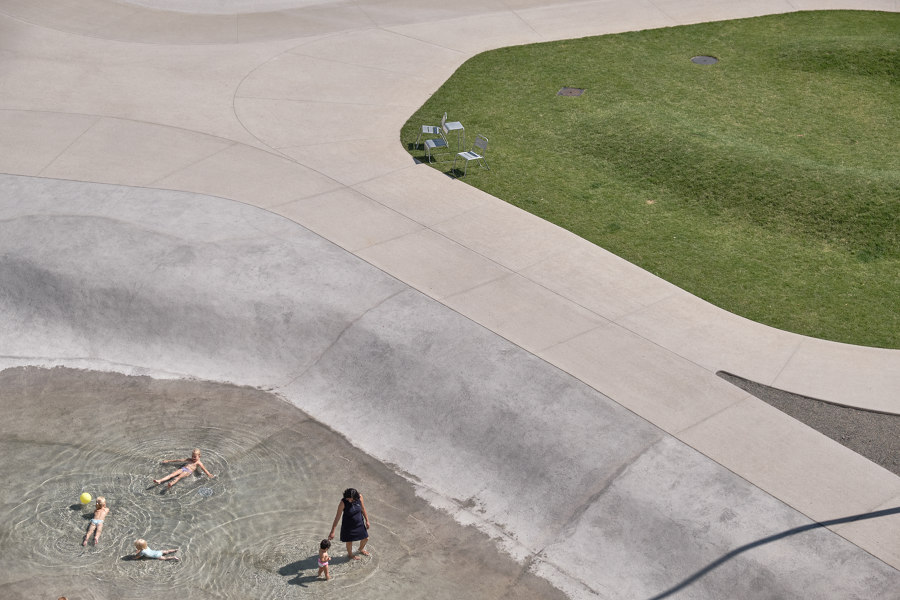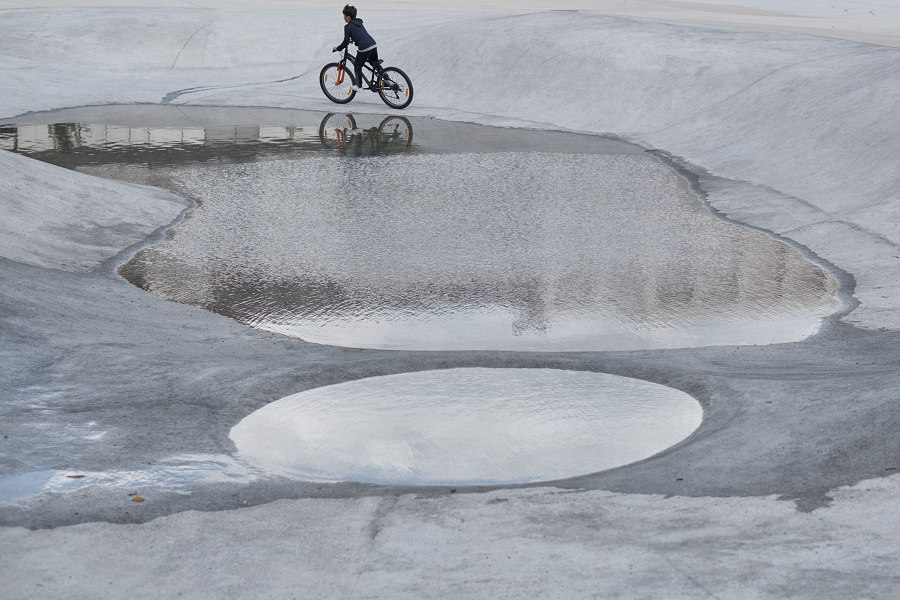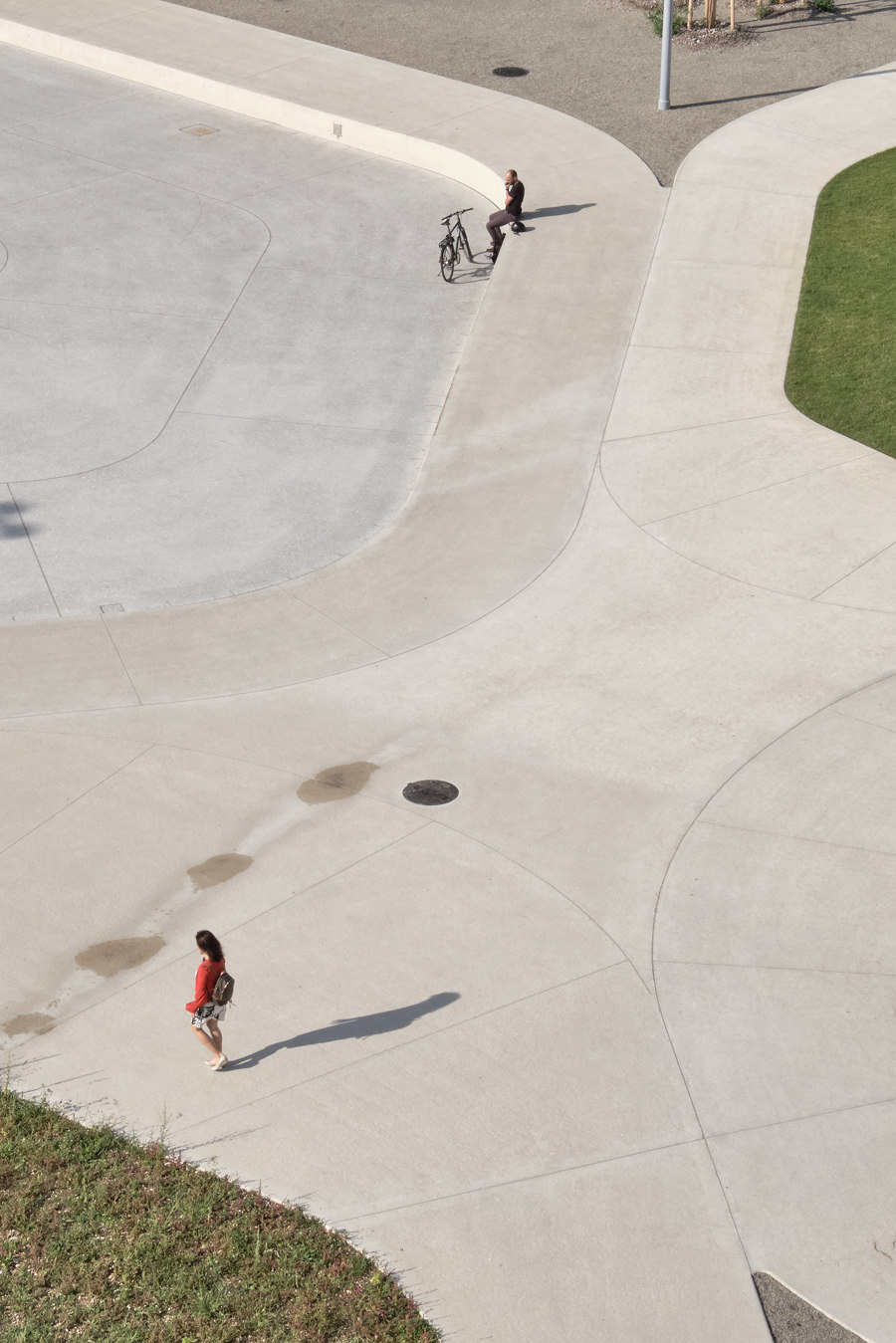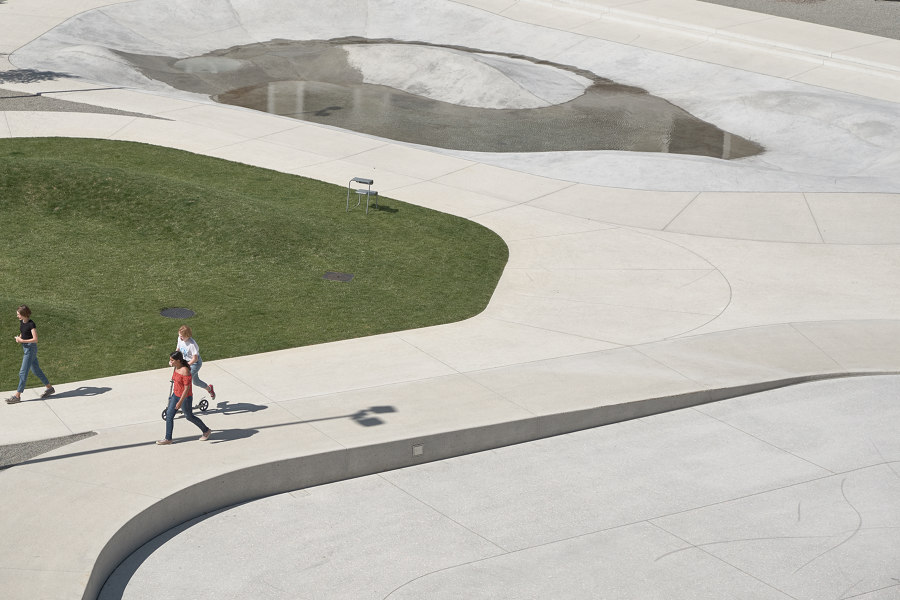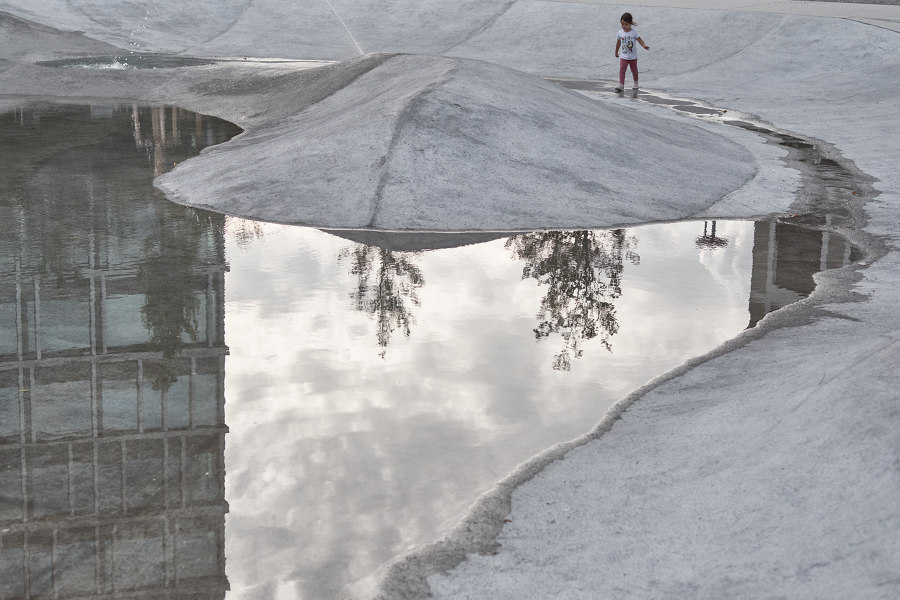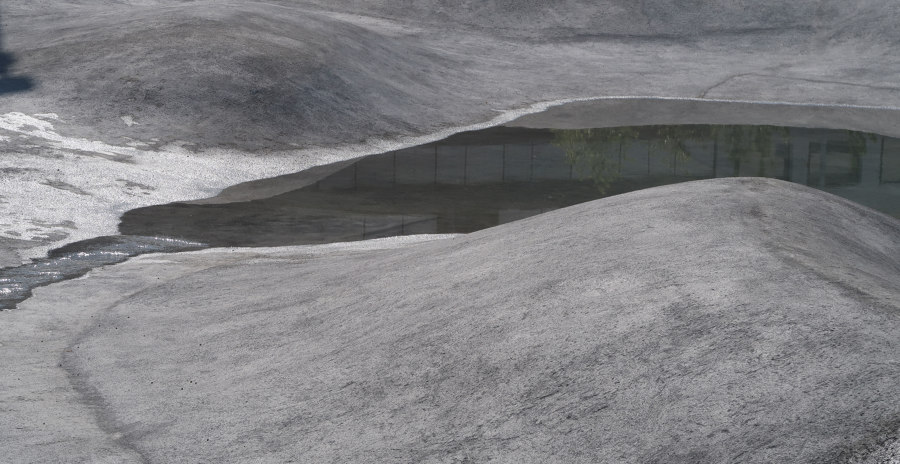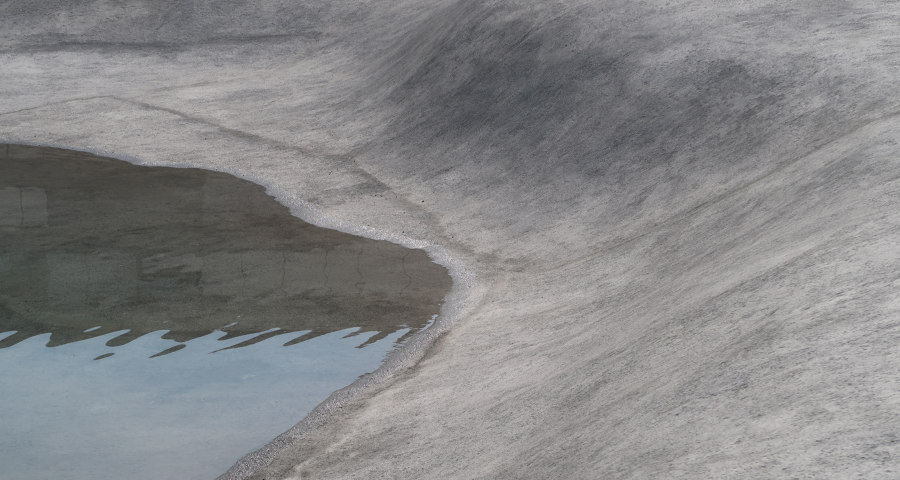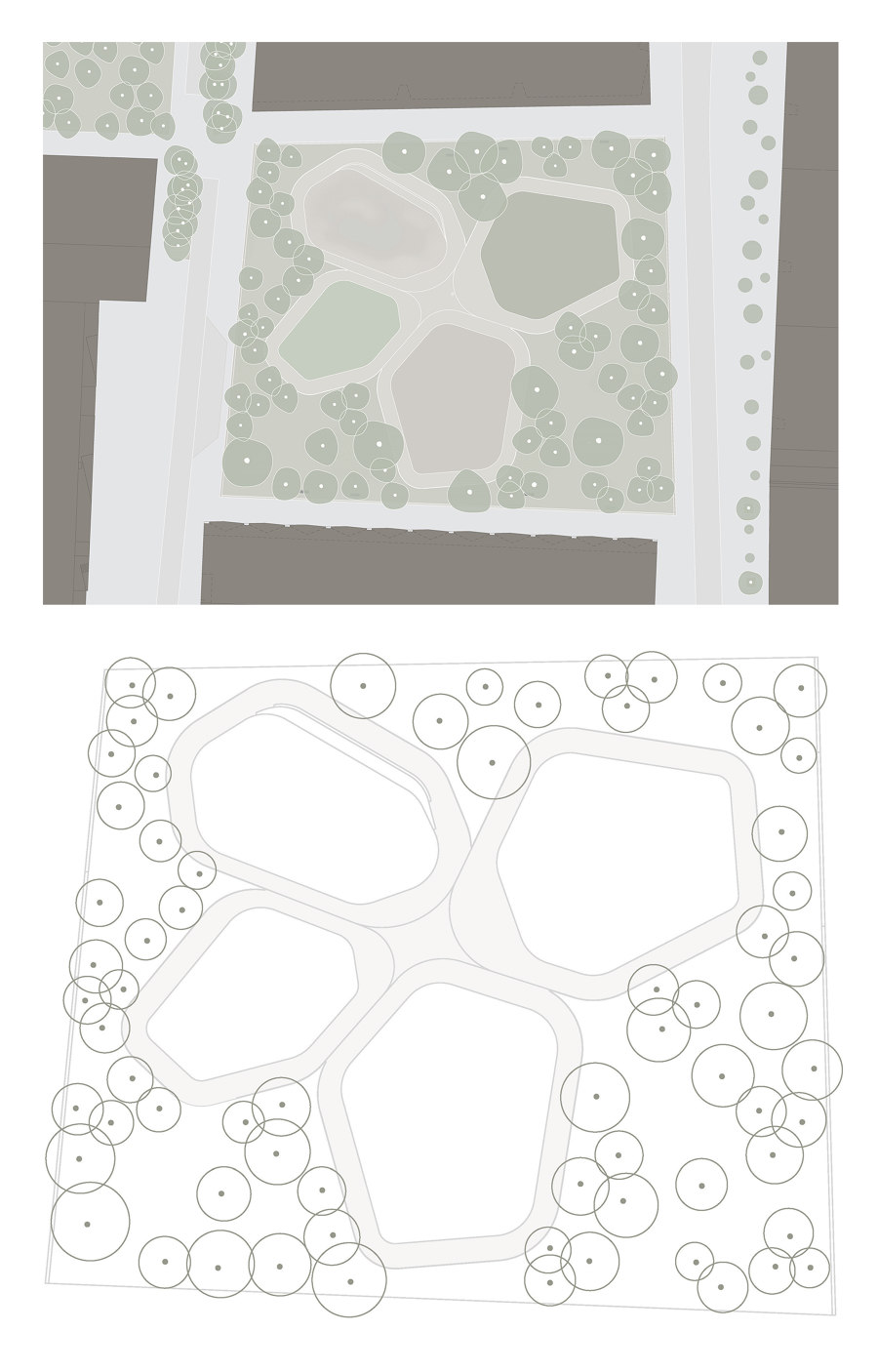Under the open sky and surrounded by countless trees, children romp cheerfully on gently contoured hills "en miniature" with mountain lakes, splashing fountains and valley streams. The pool is reminiscent of the rock formations and wide canyons that the artist Max Kämpf experienced and painted in the Navajo Nation in the southwestern United States. The new urban plaza is versatile and inviting.
The materials used display a warm colour palette in which limestone plays the primary chord, fostering a harmonious atmosphere. Through thoughtful allusions, the square tells stories about its namesake, his travels to the American Southwest as well as about the architectural culture of the city of Basel.
The gently winding promenade invites one to take a leisurely stroll redolent with scents and sounds. In the early morning, the pool is still quiet and idyllic. The rustling of the leaves in the wind intermingles with the sounds of the slowly awakening neighbourhood. The fountains begin to fill the mountain lake. In the freshly mown grass of the hills, pearls of dew still glisten. One smells wild flowers and grasses of the prairie in the adjacent meadow. The terrazzo floor of the "Esplanade" dazzles slightly in the rising sun.
It's a pleasure to walk around Max Kämpf-Platz. Those who are sportive can even run an Olympic lap as the four loops of the promenade correspond to a total of almost 400 metres. Stairs, chairs and benches offer opportunities to relax and engage in conversation with other people. Each path one takes at Max Kämpf-Platz is different and yet familiar - an endless course interwoven in four loops to practice the art of walking.
The shape of the paths is reminiscent of a cloverleaf, two interlaced roller coasters or even of the floor plans of centrally-planned buildings such as the churches and villas of the Renaissance. "Villa" can be used in Italian to describe the typology of an idyllic country house as well as a town, a public garden or an urban park. Site, architecture, nature and landscape all come together in the word "villa," an ambiguous term that can describe an attitude towards life or suggest an atmosphere, but in the end remains seductively indeterminate. Wouldn't it be better to call the square "Villa Max Kämpf”? It would be an astute choice because through the multivalent design, both a community garden and a "habitable" floor plan with four large “rooms” become apparent.
The number four was not chosen randomly: Max Kämpf spent a significant part of his life with the Navajos in the American Southwest. The Native Americans had a strong influence on his character and his artistic work. Their archaic rituals reflect the harmony between man and nature. The Navajos represent the cosmos as a circle and divide it into four worlds. In order to effect healing, the medicine men of the tribe enter a trance state and go through a long ritual deep into the night. They draw a circle with two intersecting axes in the sand and then begin to paint the four worlds into that figure.
The person seeking salvation then sits down in the sand picture and remains still to absorb the healing energy. The number four is therefore particularly important for the Navajos - full of positive magic, symbolism and holiness. They believe in four successive worlds. Four is also representative of their (and our) main cardinal points east, west, north and south as well as their four sacred plants corn, beans, pumpkin and tobacco.
The number four is also of elementary significance for our Central European culture: Terms such as "quarter" and "Stadtviertel" go back to the ancient Romans, who established their cities with two crossed axes that defined the centre of the city and formed four quarters. Analogous to this archaic urban order as well as to the four cardinal points, Max Kämpf-Platz is divided into four “rooms” by two main axes. The rooms have no walls however, only countless trees in the open air: Holm oaks, hop hornbeams, tupelos, Colchic maples, field maples and mountain cherries.
Materials
Laufen limestone has been used as a building material in the Basel region for countless generations. In the Art Nouveau houses of the adjacent Matthäus quarter, front garden walls, building pedestals and entrance stairs are essential features of the architecture and the street space. At Max Kämpf-Platz, limestone is the predominant material: The garden walls and the limestone channel covers surround the square, while the bush-hammered limestone concrete of the promenade and the terrazzo of limestone and "Rosso Verona" achieve a harmonious whole. This ensemble is framed by the roof of trees and the gravel plain.
Rainwater is absorbed through this generous and slightly inclined plain made of Vosges porphyry and Jura limestone gravel. The open surface is also accommodating to the both common and rare plant species that will settle there. Biodiversity and sustainability in the neighbourhood will thus be enhanced. This spontaneous garden will become further varied through its interaction with the people who use it, with traces being drawn in the large sandy herbal landscape through movement, passage and retreat.
The artist Max Kämpf
Max Kämpf was born on 15 May 1912 in Basel. In 1927 he began an apprenticeship as a flat surface painter. Already at this time he painted still lifes, landscapes and copied works of famous painters. Kämpf’s unusual talent became apparent in 1933 with the work "Strassenarbeiter (Street Worker)" and in 1934 with "Die Emigranten (The Emigrants)." These pictures made him famous in the Basel art scene. During the years 1937-1938 he attended the Basel School of Applied Arts. First exhibitions followed and Kämpf took part in various competitions, among others for a mural on the façade of the Orphanage.
The State Art Fund bought the work "Traumflug (Dream Flight)" which was subsequently shown in the Basler Kunstmuseum. His themes were socially critical memories of his youth in poverty. Kämpf also applied his creativity to the carnival. In the 1960s he created lanterns, masks and costumes for the "Kuttlebutzer" and thereby set new accents. In the early summer of 1979 he learned that he had cancer. In 1982 he painted his last works. Max Kämpf died on 26 September 1982 in Basel. More information about the man and the artist Max Kämpf:
Design Team:
Gaetano Castiello
Client and Project Management: Building and Transport Department of the Canton of Basel-Stadt City Nursery
Civil Engineering Office: Basel-Stadt
Mobility: Basel-City
Industrial Works: Basel IWB
Master Builder: Albin Borer AG
Shotcrete: Eberle Landschaftsbau und Geotechnik AG together with the artists Clemens Hunger and Bert Jan Douma
Terrazzo: Walo Bertschinger AG
